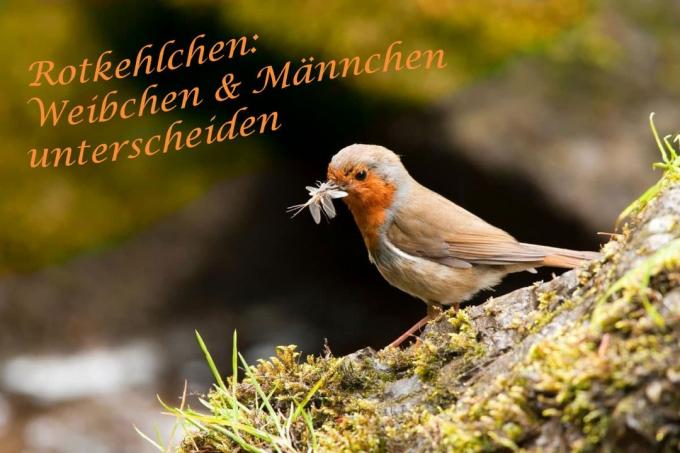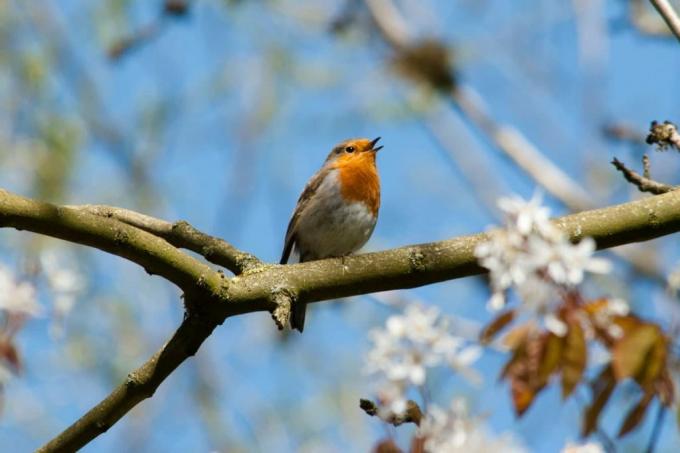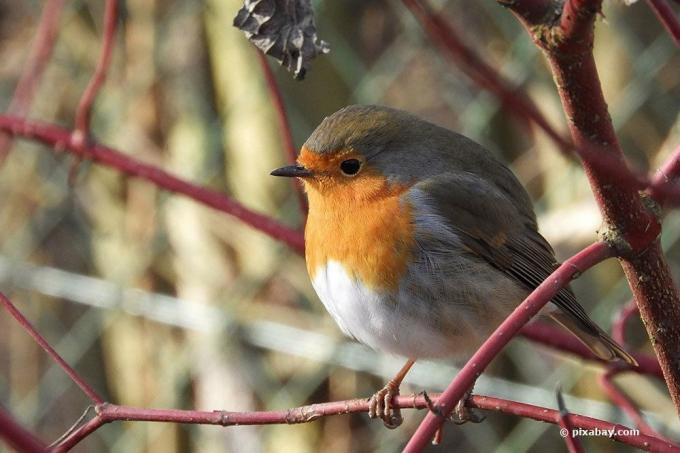
table of contents
- Volume and duration of the singing
- Color and plumage
- size
- feeding
- Raising the chicks
- Territorial behavior
- Nest building
- observation
- frequently asked Questions
It is not easy to distinguish between males and females in robins, because size, plumage and song are very similar. With the right knowledge, it is still possible to notice differences.
In a nutshell
- Robins are difficult to distinguish by sex
- the age of the birds must be known for an exact distinction
- Nesting behavior but also plumage, dimensions and song can be indications
- Males and females can be more easily differentiated during the courtship season and with offspring
Volume and duration of the singing
The female birds of this species usually sing quieter and shorter than the male representatives. Although they can sing almost as melodically as their male counterparts, the difference is still noticeable in a direct comparison.
In addition, the songbirds can primarily be heard during the courtship season. The female Erithacus rubecula - as the bird species is scientifically called - then sing to draw attention to themselves and to encourage the male conspecifics to feed.

Color and plumage
The feathers of young birds are brownish-gray. An orange breast does not develop until later. From around the age of two, the proportion of gray in the male Erithacus rubecula increases again on the breast. As a result, the orange to rust-brown color works off and looks more like a bib or a collar.
In the female animals, however, the proportion of color remains the same. However, this factor only serves as a distinguishing feature if the age of the birds is known. Otherwise a female robin cannot be distinguished from a young male conspecific.
size
As with many other animal species, the male birds are slightly larger than the female. With increasing age, the breasts of males become wider. As with the plumage, a comparison and knowledge of the age are required to distinguish.
feeding
The courtship behavior includes, among other things, that the males feed the females. If this procedure can be observed in two adult animals, the differentiation is comparatively easy.
The male bird thus shows that he can prove himself as a provider.

Raising the chicks
When the birds breed and the chicks hatch, the mother remains almost completely in the nest for at least two weeks. During this time, the male bird is largely occupied with providing food for both the young birds and the mother.
Active during the Breeding season so flying robins are usually male specimens.
Territorial behavior
Furthermore, one can distinguish between male and female robins based on their territorial behavior. Especially during the courtship and breeding season. Important points are:
- similar looking birds can be confused with the Erithacus rubecula
- violent wing flapping while sitting mostly occurs only in female specimens
- males stay in a territory
- female birds tend to be in nesting areas
Tip: If a bird stays in the same area over and over again, it is very likely a male animal.

Nest building
Both sexes are involved in nest building. It is therefore difficult to differentiate between them. However, knowing the location of a nest is helpful because it allows the birds to be observed for a longer period of time. This is the only way to differentiate the sex of the Erithacus rubecula with relative certainty.
However, the animals build their nests in very different positions. For example:
- Holes in the ground
- Hedges
- Wall openings
- bushes
The nest is made of various materials, including:
- feathers
- Fur and hair
- moss
- Twigs and dried grass
Tip: The nests are mostly close to the ground and resemble a bowl in shape.

observation
Continuous observation is useful to distinguish. However, since the birds are very shy and territorial, this should not be done at close range.
Practical aids are therefore:
- binoculars
- photographic recordings
- Wildlife camera
frequently asked Questions
The birds lay eggs once or twice a year. The breeding season can therefore last from April to August.
Depending on the temperatures in winter, the animals are migratory or resident birds. In northern Europe and in the east it is migratory birds that overwinter in the Mediterranean area.
Forests with thickets and gardens with hedges and bushes are popular nesting sites. If you want to attach nest boxes, you should position them close to the ground but protected from other animals.
